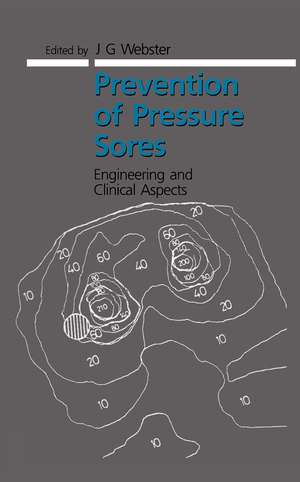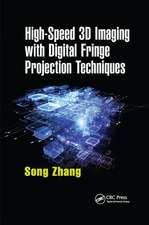Prevention of Pressure Sores: Engineering and Clinical Aspects: Series in Medical Physics and Biomedical Engineering
Autor J.G Websteren Limba Engleză Paperback – 7 ian 2019
| Toate formatele și edițiile | Preț | Express |
|---|---|---|
| Paperback (1) | 537.14 lei 6-8 săpt. | |
| CRC Press – 7 ian 2019 | 537.14 lei 6-8 săpt. | |
| Hardback (1) | 1438.46 lei 6-8 săpt. | |
| CRC Press – iun 1991 | 1438.46 lei 6-8 săpt. |
Din seria Series in Medical Physics and Biomedical Engineering
-
 Preț: 362.42 lei
Preț: 362.42 lei - 5%
 Preț: 1304.46 lei
Preț: 1304.46 lei - 5%
 Preț: 346.24 lei
Preț: 346.24 lei - 15%
 Preț: 673.74 lei
Preț: 673.74 lei - 5%
 Preț: 339.69 lei
Preț: 339.69 lei -
 Preț: 356.64 lei
Preț: 356.64 lei -
 Preț: 359.37 lei
Preț: 359.37 lei -
 Preț: 364.30 lei
Preț: 364.30 lei -
 Preț: 366.36 lei
Preț: 366.36 lei - 9%
 Preț: 632.16 lei
Preț: 632.16 lei -
 Preț: 368.77 lei
Preț: 368.77 lei -
 Preț: 373.96 lei
Preț: 373.96 lei -
 Preț: 339.86 lei
Preț: 339.86 lei - 46%
 Preț: 352.95 lei
Preț: 352.95 lei - 23%
 Preț: 371.45 lei
Preț: 371.45 lei - 25%
 Preț: 1057.26 lei
Preț: 1057.26 lei - 5%
 Preț: 546.82 lei
Preț: 546.82 lei - 26%
 Preț: 1098.62 lei
Preț: 1098.62 lei - 49%
 Preț: 680.73 lei
Preț: 680.73 lei - 18%
 Preț: 1064.36 lei
Preț: 1064.36 lei - 22%
 Preț: 325.85 lei
Preț: 325.85 lei - 5%
 Preț: 914.71 lei
Preț: 914.71 lei - 23%
 Preț: 377.01 lei
Preț: 377.01 lei - 30%
 Preț: 848.15 lei
Preț: 848.15 lei - 15%
 Preț: 489.26 lei
Preț: 489.26 lei - 18%
 Preț: 1068.15 lei
Preț: 1068.15 lei - 28%
 Preț: 603.31 lei
Preț: 603.31 lei - 26%
 Preț: 1042.56 lei
Preț: 1042.56 lei - 25%
 Preț: 851.88 lei
Preț: 851.88 lei - 5%
 Preț: 910.15 lei
Preț: 910.15 lei - 15%
 Preț: 461.03 lei
Preț: 461.03 lei - 5%
 Preț: 915.27 lei
Preț: 915.27 lei - 18%
 Preț: 1438.46 lei
Preț: 1438.46 lei - 28%
 Preț: 1046.99 lei
Preț: 1046.99 lei - 5%
 Preț: 1038.35 lei
Preț: 1038.35 lei - 14%
 Preț: 312.45 lei
Preț: 312.45 lei - 5%
 Preț: 747.83 lei
Preț: 747.83 lei - 27%
 Preț: 1228.34 lei
Preț: 1228.34 lei - 18%
 Preț: 1059.45 lei
Preț: 1059.45 lei - 15%
 Preț: 682.83 lei
Preț: 682.83 lei - 25%
 Preț: 1195.93 lei
Preț: 1195.93 lei - 18%
 Preț: 887.88 lei
Preț: 887.88 lei
Preț: 537.14 lei
Preț vechi: 631.93 lei
-15% Nou
Puncte Express: 806
Preț estimativ în valută:
102.81€ • 111.72$ • 86.42£
102.81€ • 111.72$ • 86.42£
Carte tipărită la comandă
Livrare economică 22 aprilie-06 mai
Preluare comenzi: 021 569.72.76
Specificații
ISBN-13: 9780367456009
ISBN-10: 0367456001
Pagini: 260
Dimensiuni: 156 x 234 mm
Greutate: 0.37 kg
Ediția:1
Editura: CRC Press
Colecția CRC Press
Seria Series in Medical Physics and Biomedical Engineering
ISBN-10: 0367456001
Pagini: 260
Dimensiuni: 156 x 234 mm
Greutate: 0.37 kg
Ediția:1
Editura: CRC Press
Colecția CRC Press
Seria Series in Medical Physics and Biomedical Engineering
Public țintă
ProfessionalCuprins
Preface, 1 The Cause of Pressure Sores,1.1 Incidence of pressure sores, 1.2 Description of tissues, 1.3 Stages of development, 1.4 Insufficient tissue perfusion, 1.5 Contribution of mechanical forces, 1.6 Contribution of related factors, 1.7 Spinal cord injured persons, 1.8 Study questions 2 Pressure Distribution in Tissue, 2.1 Soft tissue physical model, 2.2 Computer model, 2.3 Deep pressure from skin pressure, 2.4 Depth where pressure sore originates, 2.5 Measuring skin blood flow, 2.6 Pressure distribution at different locations, 2.7 Study questions, 3 Signs of Pressure Sores Basel Taha, 3.1 Early warning signs, 3.2 Pressure sore risk assessment, 3.3 Objective evaluation of skin status, 3.4 Study questions, 4 Behavior to Prevent Pressure Sores, 4.1 Able-bodied persons, 4.2 Spinal cord injured persons, 4.3 Aged persons, 4.4 Operating table, 4.5 Pressure management team, 4.6 Patient compliance outside institution, 4.7 Study questions, 5 Seat Cushions, 5.1 Cushion types and materials, 5.2 Methods of design, 5.3 Cushion interface conditions, 5.4 Objective test methods for evaluation, 5.5 Subjective methods for evaluation, 5.6 Study questions,6 Other Support Surfaces, 6.1 General considerations, 6.2 Wheelchair design, 6.3 Hospital bed, 6.4 Operating table, 6.5 Bed traction, 6.6 Spinal board, 6.7 Study questions, 7 Complex Pressure Relief Methods, 7.1 Alternating pressure devices, 7.2 Airbeds, 7.3 Water beds, 7.4 Sand bed, 7.5 Assisted turning beds, 7.6 Net suspension bed, 7.7 Pressure distribution on different beds, 7.8 Automated wheelchair seats, 7.9 Study questions, 8 Bladder Pressure Sensors, 8.1 Sensor specification, 8.2 Spatial distribution, 8.3 Bladder sensors with built-in switch, 8.4 Bladder sensors without built-in switch, 8.5 Evaluation, 8.6 Study questions, 9 Conventional Pressure Sensors, 9.1 General considerations, 9.2 Conductive polymer pressure sensors, 9.3 Semiconductor strain gages, 9.4 Metal strain gages, 9.5 Capacitive pressure sensors, 9.6 Optoelec
Descriere
Prevention of Pressure Sores: Engineering and Clinical Aspects collects together material from throughout the literature. The book first discusses the causes of pressure sores and then describes warning signs and behavior to prevent the incidence of pressure sores. It also examines the numerous different devices used to alleviate and prevent pressu








